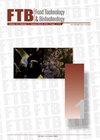In Silico, In Vitro and Ex Vivo Evaluation of the Antihyperglycaemic, Antioxidant and Cytotoxic Properties of Coccinia grandis L. Leaf Extract
IF 2.3
4区 农林科学
Q3 BIOTECHNOLOGY & APPLIED MICROBIOLOGY
引用次数: 0
Abstract
Research background. Coccinia grandis (L.) is traditionally used for the management of diabetes mellitus. Since, scientific evidence and the mechanism of action have yet to be investigated extensively, this study aimed to evaluate the antidiabetic and cytotoxic effects together with the optimization and development of a scale-up process design for higher yields of bioactive phytocompounds from C. grandis. Experimental approach. The in silico study was performed to predict the binding affinity of phytocompounds of C. grandis for α-amylase and α-glucosidase enzymes involved in the pathophysiology of diabetes with pharmacokinetic assessment. Response surface methodology was employed to determine the optimum values for TPC, TFC, TTC and antioxidant activities (DPPH and FRAP) across 17 separate experimental runs that varied microwave-assisted extraction parameters like temperature (50–70 °C), power (400–1000 W) and time (15-45 min). The purification and identification phytocompounds were done by column chromatography, TLC, UV-Visible, FTIR and LC-MS spectral analysis, respectively. The in vitro antidiabetic activity was done by α-amylase and α-glucosidase enzymatic inhibitory assay while cytotoxic investigations were done by percentage hemolytic activity, MTT and CAM assay. Results and conclusions. The reported major bioactive compounds have demonstrated an excellent binding affinity for α-amylase and α-glucosidase enzymes in the range of 3.7 to 8.6 kcal/mol with good pharmacokinetic properties and toxicities ranging from low to medium. The bioactive constituents such as TPC, TFC, TTC and antioxidant activities like DPPH and FRAP were found to be high and depend on the microwave-assisted optimized extraction parameters like temperature, time and power: 55 °C, 45 min, and 763 W, respectively. Sixteen compounds were identified by their FTIR and LC-MS spectra in the plant sample after preliminary identification, purification and TLC. The percentage enzyme inhibition was dependent on the concentration of the extract (7.81–125 µg/mL), and was found to be higher than acarbose. The hemolytic activity was found to be compatible with ISO standards and in MTT and CAM assay, low toxicity was observed in the range 7.81−125 µg/mL, which supports its potential use as antidiabetic drug formulation as well as functional food development. Novelty and scientific contribution. Researchers, scientists, and businesspeople in the food and pharmaceutical sectors will have new opportunities due to the study's findings to develop antidiabetic food formulations and medications to help diabetics for better control their condition and maintain overall health.对大叶椰子叶提取物抗高血糖、抗氧化和细胞毒性特性的硅学、体外和体内评估
研究背景。Coccinia grandis (L.) 传统上用于治疗糖尿病。由于其科学依据和作用机制尚未得到广泛研究,本研究旨在评估其抗糖尿病和细胞毒性作用,同时优化和开发放大工艺设计,以提高大叶椰子中生物活性植物化合物的产量。实验方法。通过药代动力学评估,进行了硅学研究,以预测鹅掌楸植物化合物与糖尿病病理生理学中的α-淀粉酶和α-葡萄糖苷酶的结合亲和力。在改变温度(50-70 °C)、功率(400-1000 W)和时间(15-45 分钟)等微波辅助萃取参数的 17 次独立实验中,采用响应面方法确定了 TPC、TFC、TTC 和抗氧化活性(DPPH 和 FRAP)的最佳值。植物化合物的纯化和鉴定分别通过柱层析、TLC、UV-Visible、FTIR 和 LC-MS 光谱分析完成。体外抗糖尿病活性采用α-淀粉酶和α-葡萄糖苷酶酶抑制试验,细胞毒性研究采用溶血活性百分比、MTT和CAM试验。所报告的主要生物活性化合物与α-淀粉酶和α-葡萄糖苷酶的结合亲和力在 3.7 至 8.6 kcal/mol 之间,具有良好的药代动力学特性,毒性从低到中。生物活性成分(如 TPC、TFC、TTC)和抗氧化活性(如 DPPH 和 FRAP)较高,且取决于微波辅助优化萃取参数,如温度、时间和功率:分别为 55 ℃、45 分钟和 763 W。经过初步鉴定、纯化和 TLC 分析,通过傅立叶变换红外光谱和 LC-MS 图谱确定了植物样品中的 16 种化合物。酶抑制百分比取决于提取物的浓度(7.81-125 µg/mL),发现提取物的酶抑制百分比高于阿卡波糖。溶血活性符合 ISO 标准,在 MTT 和 CAM 试验中,在 7.81-125 µg/mL 的范围内观察到低毒性,这支持了其作为抗糖尿病药物制剂和功能食品开发的潜在用途。这项研究的发现将为食品和制药行业的研究人员、科学家和商人提供新的机会,开发抗糖尿病食品配方和药物,帮助糖尿病患者更好地控制病情,保持整体健康。
本文章由计算机程序翻译,如有差异,请以英文原文为准。
求助全文
约1分钟内获得全文
求助全文
来源期刊

Food Technology and Biotechnology
工程技术-生物工程与应用微生物
CiteScore
3.70
自引率
0.00%
发文量
33
审稿时长
12 months
期刊介绍:
Food Technology and Biotechnology (FTB) is a diamond open access, peer-reviewed international quarterly scientific journal that publishes papers covering a wide range of topics, including molecular biology, genetic engineering, biochemistry, microbiology, biochemical engineering and biotechnological processing, food science, analysis of food ingredients and final products, food processing and technology, oenology and waste treatment.
The Journal is published by the University of Zagreb, Faculty of Food Technology and Biotechnology, Croatia. It is an official journal of Croatian Society of Biotechnology and Slovenian Microbiological Society, financed by the Croatian Ministry of Science and Education, and supported by the Croatian Academy of Sciences and Arts.
 求助内容:
求助内容: 应助结果提醒方式:
应助结果提醒方式:


